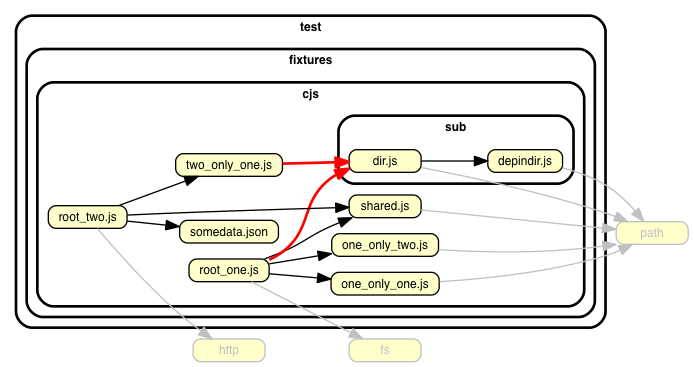Validate and visualize dependencies. With your rules. JavaScript. TypeScript. CoffeeScript. ES6, CommonJS, AMD.
- Run through the dependencies in any JavaScript, TypeScript or CoffeeScript project and ...
- ... validate them against a set of (your own) rules
- ... report violated rules
- in text (for in your builds)
- in graphics (for on your eyeballs)
As a nice side effect it can generate cool dependency graphs you can stick on the wall to impress your grandma.
Dependency cruiser works most comfortably when you install it globally.
npm install --global dependency-cruiser
To create a graph of the dependencies in your src folder, you'd run dependency
cruiser with output type dot and run GraphViz dot on the result. In
a one liner:
dependency-cruise --exclude "^node_modules" --output-type dot src | dot -T svg > dependencygraph.svgThe --exclude "^node_modules" makes sure dependency-cruiser does not scan
paths starting with node_modules.
- You can read more about what you can do with
--excludeand other command line options in the command line interface documentation. - Real world samples contains dependency cruises of some of the most used projects on npm.
To have dependency-cruiser report on dependencies going into the test folder
(which is totally weird, right?) create a rules file (e.g. my-rules.json)
and put this in there:
{
"forbidden": [{
"name": "not-to-test",
"comment": "don't allow dependencies from outside the test folder to test",
"severity": "error",
"from": { "pathNot": "^test" },
"to": { "path": "^test" }
}]
}- To read more about writing rules check the writing rules section.
- There is practical rules configuration to get you started here
Pass the --validate parameter, to the command line followed by the rules
file.
Most output-types will show violations of your rules in one way or another.
The dot reporter, for instance, will color edges representing violated
dependencies in a signaling color (red for errors, orange for warnings) - the
picture on top of this README is a sample of that.
The err reporter only emits (text) output when there's something wrong.
This is useful when you want to check the rules in your build process:
dependency-cruise --validate my-rules.json --output-type err src- Read more about the err, dot, but also the csv and html reporters in the command line interface documentation.
- dependency-cruiser uses itself to check on itself in its own build process;
see the
dependency-cruisetarget in the Makefile
You've come to the right place :-) :
- Marijn Haverbeke and other people who colaborated on acorn - the excelent javascript parser dependency-cruiser uses to infer dependencies.




